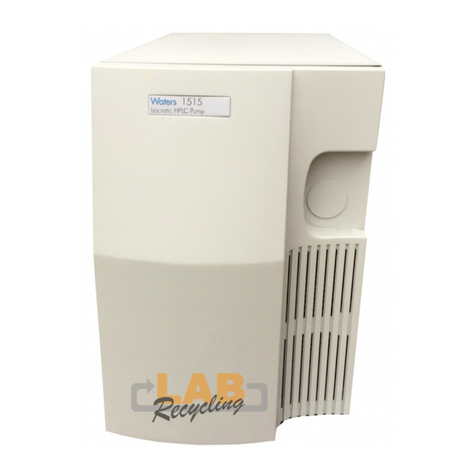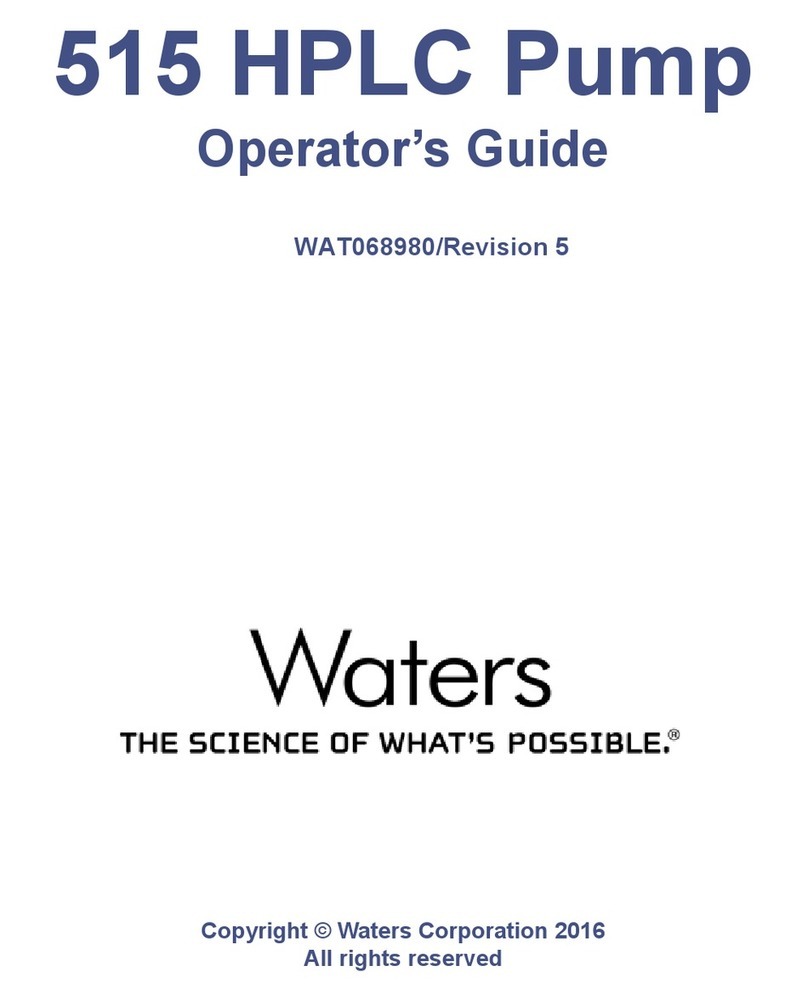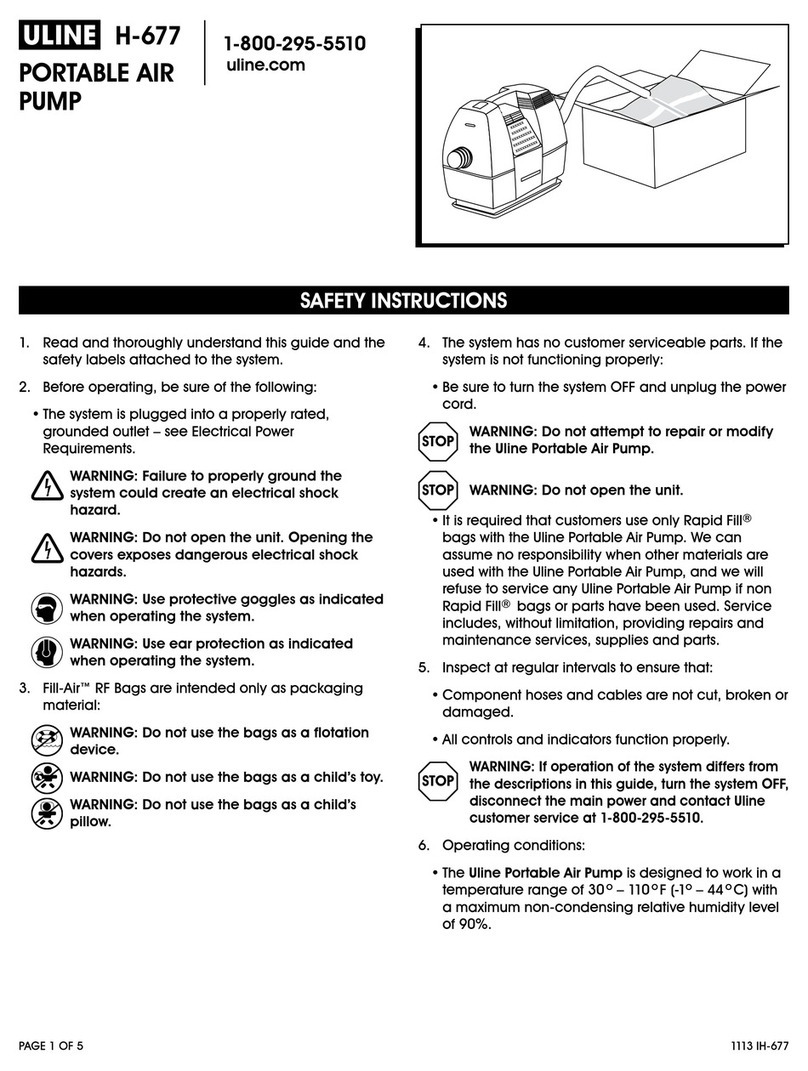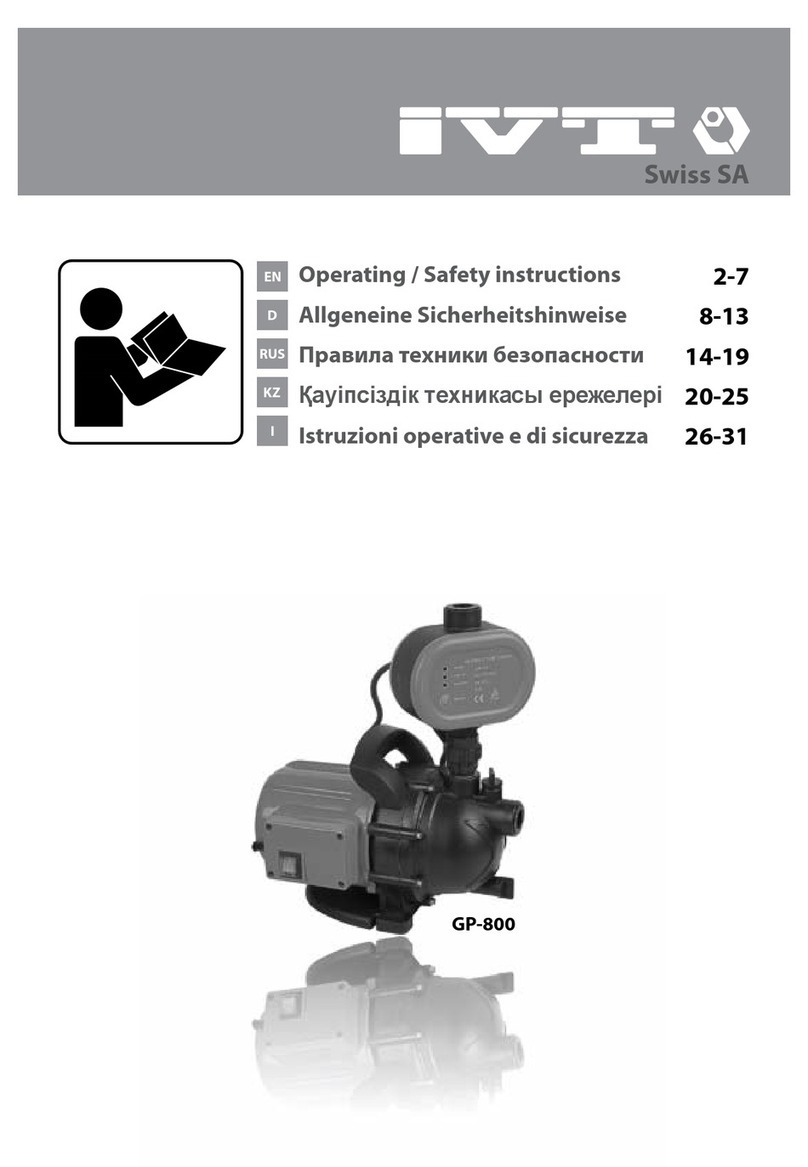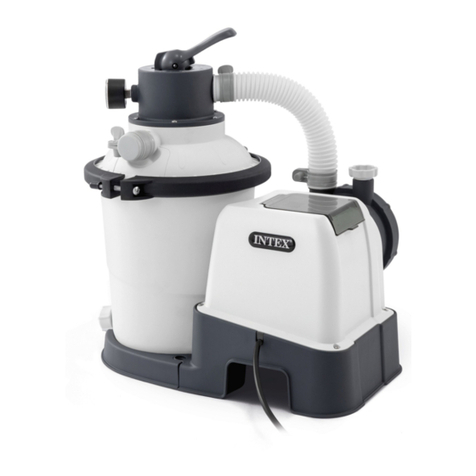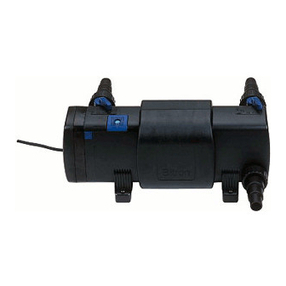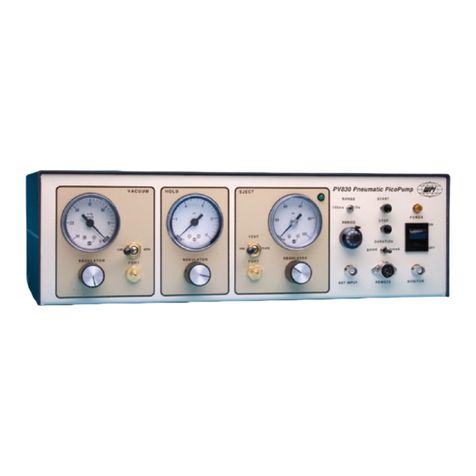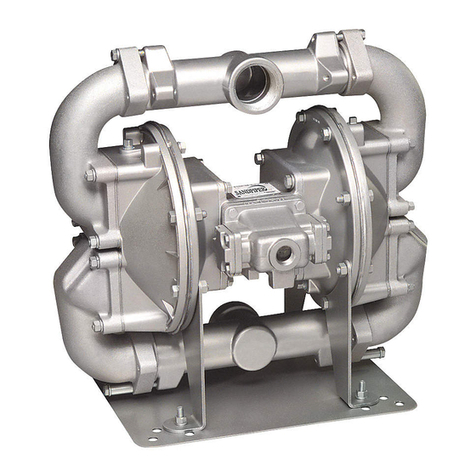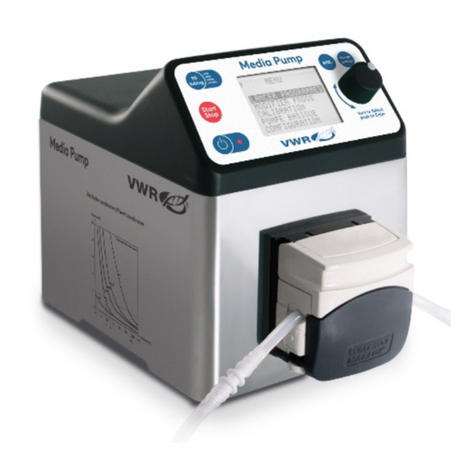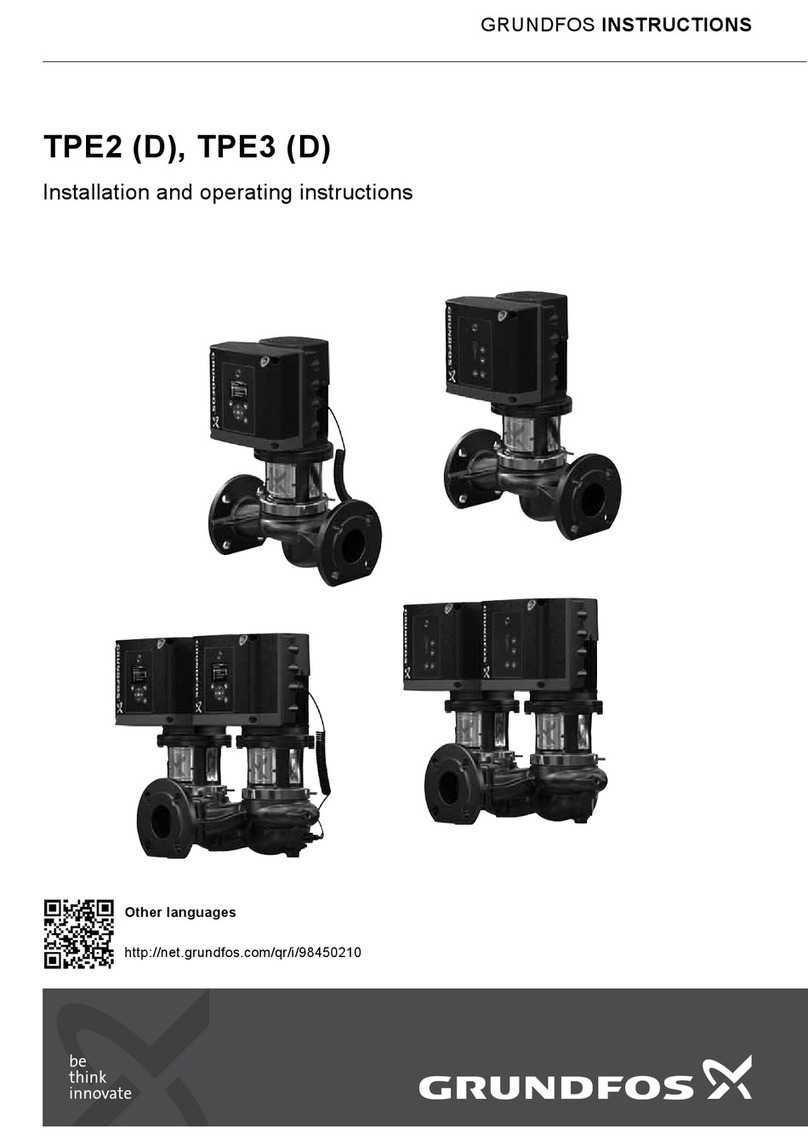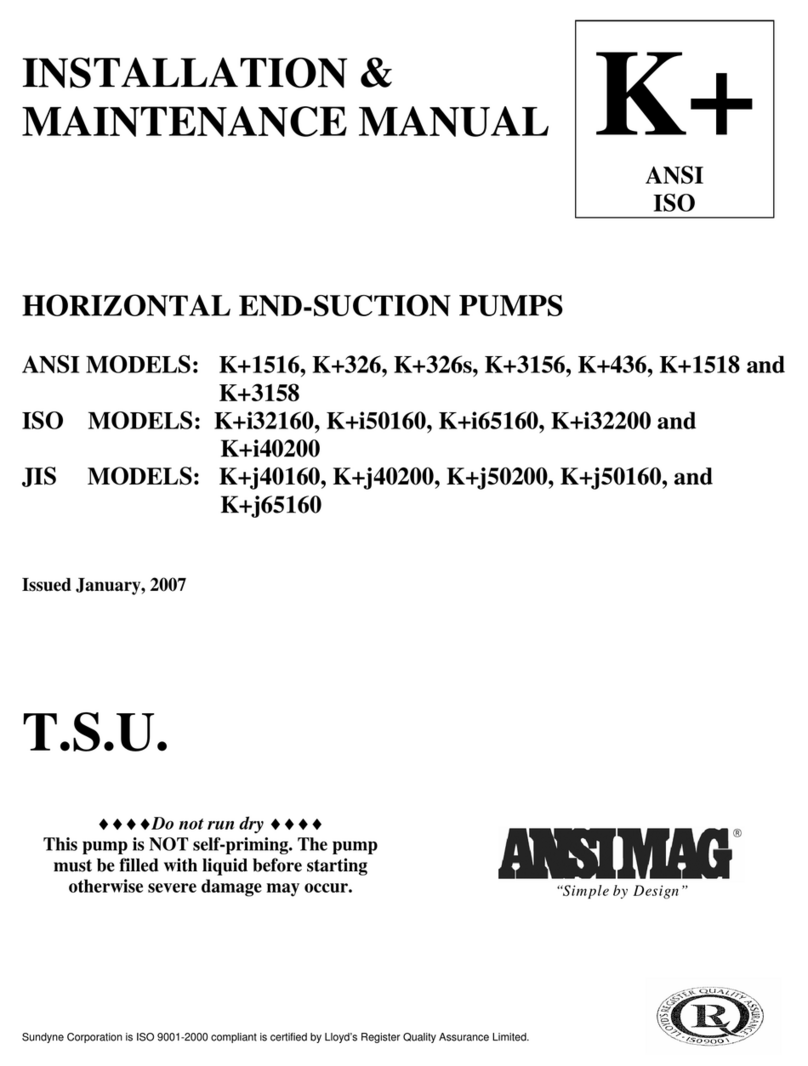Waters 1525M Product manual

Waters 1525µ and
1525EF HPLC Pump
Installation and Maintenance Guide
34 Maple Stre
et
Milford, MA 0175
7
71500152504, Revision
A

NOTICE
The information in this document is subject to change without notice and should not be
construed as a commitment by Waters Corporation. Waters Corporation assumes no
responsibility for any errors that may appear in this document. This document is believed
to be complete and accurate at the time of publication. In no event shall Waters
Corporation be liable for incidental or consequential damages in connection with, or
arising from, the use of this document.
© 2003 WATERS CORPORATION. PRINTED IN THE UNITED STATES OF AMERICA.
ALL RIGHTS RESERVED. THIS DOCUMENT OR PARTS THEREOF MAY NOT BE
REPRODUCED IN ANY FORM WITHOUT THE WRITTEN PERMISSION OF THE
PUBLISHER.
Micromass and Waters are registered trademarks, and FractionLynx and MassLynx are
trademarks of Waters Corporation.
Microsoft is a registered trademark, and Windows is a trademark of Microsoft Corporation.
National Instruments is trademark of National Instruments Corporation.
Tefzel is a registered trademark of E. I. du Pont de Nemours and Company.
All other trademarks or registered trademarks are the sole property of their respective
owners.

Note: When you use the instrument, follow generally accepted procedures for quality
control and methods development.
If you observe a change in the retention of a particular compound, in the resolution
between two compounds, or in peak shape, immediately determine the reason for the
changes. Until you determine the cause of a change, do not rely on the separation results.
Note: The Installation Category (Overvoltage Category) for this instrument is Level II. The
Level II Category pertains to equipment that receives its electrical power from a local level,
such as an electrical wall outlet.
STO
P
Atención: Changes or modifications to this unit not expressly approved by the party
responsible for compliance could void the user’s authority to operate the equipment.
Important : Toute modification sur cette unité n’ayant pas été expressément approuvée
par l’autorité responsable de la conformité à la réglementation peut annuler le droit de
l’utilisateur à exploiter l’équipement.
Achtung: Jedwede Änderungen oder Modifikationen an dem Gerät ohne die
ausdrückliche Genehmigung der für die ordnungsgemäße Funktionstüchtigkeit
verantwortlichen Personen kann zum Entzug der Bedienungsbefugnis des Systems
führen.
Avvertenza: eventuali modifiche o alterazioni apportate a questa unità e non
espressamente approvate da un ente responsabile per la conformità annulleranno
l’autorità dell’utente ad operare l’apparecchiatura.
Atención: cualquier cambio o modificación efectuado en esta unidad que no haya sido
expresamente aprobado por la parte responsable del cumplimiento puede anular la
autorización del usuario para utilizar el equipo.

Caution: Use caution when working with any polymer tubing under pressure:
• Always wear eye protection when near pressurized polymer tubing.
• Extinguish all nearby flames.
• Do not use Tefzel tubing that has been severely stressed or kinked.
• Do not use Tefzel tubing with tetrahydrofuran (THF) or concentrated nitric or
sulfuric acids.
• Be aware that methylene chloride and dimethyl sulfoxide cause Tefzel tubing to
swell, which greatly reduces the rupture pressure of the tubing.
Attention : Soyez très prudent en travaillant avec des tuyaux de polymères sous
pression :
• Portez toujours des lunettes de protection quand vous vous trouvez à proximité de
tuyaux de polymères.
• Eteignez toutes les flammes se trouvant à proximité.
• N'utilisez pas de tuyau de Tefzel fortement abîmé ou déformé.
• N'utilisez pas de tuyau de Tefzel avec de l'acide sulfurique ou nitrique, ou du
tétrahydrofurane (THF).
• Sachez que le chlorure de méthylène et le sulfoxyde de diméthyle peuvent
provoquer le gonflement des tuyaux de Tefzel, diminuant ainsi fortement leur
pression de rupture.
Vorsicht: Bei der Arbeit mit Polymerschläuchen unter Druck ist besondere Vorsicht
angebracht:
• In der Nähe von unter Druck stehenden Polymerschläuchen stets Schutzbrille
tragen.
• Alle offenen Flammen in der Nähe löschen.
• Keine Tefzel-Schläuche verwenden, die stark geknickt oder überbeansprucht sind.
• Tefzel-Schläuche nicht für Tetrahydrofuran (THF) oder konzentrierte Salpeter- oder
Schwefelsäure verwenden.
• Durch Methylenchlorid und Dimethylsulfoxid können Tefzel-Schläuche quellen;
dadurch wird der Berstdruck des Schlauches erheblich reduziert.

Precauzione: prestare attenzione durante le operazioni con i tubi di polimero sotto
pressione:
• Indossare sempre occhiali da lavoro protettivi nei pressi di tubi di polimero
pressurizzati.
• Estinguere ogni fonte di ignizione circostante.
• Non utilizzare tubi Tefzel soggetti a sollecitazioni eccessive o incurvati.
• Non utilizzare tubi Tefzel contenenti tetraidrofurano (THF) o acido solforico o nitrico
concentrato.
• Tenere presente che il cloruro di metilene e il dimetilsolfossido provocano
rigonfiamento nei tubi Tefzel, che riducono notevolmente il limite di pressione di
rottura dei tubi stessi.
Advertencia: manipular con precaución los tubos de polímero bajo presión:
• Protegerse siempre los ojos en las proximidades de tubos de polímero bajo
presión.
• Apagar todas las llamas que estén a proximidad.
• No utilizar tubos Tefzel que hayan sufrido tensiones extremas o hayan sido
doblados.
• No utilizar tubos Tefzel con tetrahidrofurano (THF) o ácidos nítrico o sulfúrico
concentrados.
• No olvidar que el cloruro de metileno y el óxido de azufre dimetilo dilatan los tubos
Tefzel, lo que reduce en gran medida la presión de ruptura de los tubos.


Caution: The user shall be made aware that if the equipment is used in a manner not
specified by the manufacturer, the protection provided by the equipment may be impaired.
Attention : L’utilisateur doit être informé que si le matériel est utilisé d’une façon non
spécifiée par le fabricant, la protection assurée par le matériel risque d’être défectueuses.
Vorsicht: Der Benutzer wird darauf aufmerksam gemacht, dass bei unsachgemäßer
Verwenddung des Gerätes unter Umständen nicht ordnungsgemäß funktionieren.
Precauzione: l’utente deve essere al corrente del fatto che, se l’apparecchiatura viene
usta in un modo specificato dal produttore, la protezione fornita dall’apparecchiatura
potrà essere invalidata.
Advertencia: el usuario deberá saber que si el equipo se utiliza de forma distinta a la
especificada por el fabricante, las medidas de protección del equipo podrían ser
insuficientes.

Caution: To protect against fire hazard, replace fuses with those of the same type and
rating.
Attention : Remplacez toujours les fusibles par d’autres du même type et de la même
puissance afin d’éviter tout risque d’incendie.
Vorsicht: Zum Schutz gegen Feuergefahr die Sicherungen nur mit Sicherungen des
gleichen Typs und Nennwertes ersetzen.
Precauzione: per una buona protezione contro i rischi di incendio, sostituire i fusibili con
altri dello stesso tipo e amperaggio.
Advertencia: sustituya los fusibles por otros del mismo tipo y características para evitar
el riesgo de incendio.

Caution: To avoid possible electrical shock, disconnect the power cord before servicing
the instrument.
Attention : Afin d’éviter toute possibilité de commotion électrique, débranchez le cordon
d’alimentation de la prise avant d’effectuer la maintenance de l’instrument.
Vorsicht: Zur Vermeidung von Stromschlägen sollte das Gerät vor der Wartung vom
Netz getrennt werden.
Precauzione: per evitare il rischio di scossa elettrica, scollegare il cavo di alimentazione
prima di svolgere la manutenzione dello strumento.
Precaución: para evitar descargas eléctricas, desenchufe el cable de alimentación del
instrumento antes de realizar cualquier reparación.

Commonly Used Symbols
Direct current
Courant continu
Gleichstrom
Corrente continua
Corriente continua
Alternating current
Courant alternatif
Wechselstrom
Corrente alternata
Corriente alterna
Protective conductor terminal
Borne du conducteur de protection
Schutzleiteranschluss
Terminale di conduttore con protezione
Borne del conductor de tierra

Frame or chassis terminal
Borne du cadre ou du châssis
Rahmen- oder Chassisanschluss
Terminale di struttura o telaio
Borne de la estructura o del chasis
Caution or refer to manual
Attention ou reportez-vous au guide
Vorsicht, oder lesen Sie das Handbuch
Prestare attenzione o fare riferimento alla guida
Actúe con precaución o consulte la guía
Caution, hot surface or high temperature
Attention, surface chaude ou température élevée
Vorsicht, heiße Oberfläche oder hohe Temperatur
Precauzione, superficie calda o elevata temperatura
Precaución, superficie caliente o temperatura elevada
Commonly Used Symbols (Continued)

Caution, risk of electric shock (high voltage)
Attention, risque de commotion électrique (haute tension)
Vorsicht, Elektroschockgefahr (Hochspannung)
Precauzione, rischio di scossa elettrica (alta tensione)
Precaución, peligro de descarga eléctrica (alta tensión)
Caution, risk of needle-stick puncture
Attention, risques de perforation de la taille d’une aiguille
Vorsicht, Gefahr einer Spritzenpunktierung
Precauzione, rischio di puntura con ago
Precaución, riesgo de punción con aguja
Caution, ultraviolet light
Attention, rayonnement ultrviolet
Vorsicht, Ultraviolettes Licht
Precauzione, luce ultravioletta
Precaución, emisiones de luz ultravioleta
Commonly Used Symbols (Continued)
UV

Fuse
Fusible
Sicherung
Fusibile
Fusible
Electrical power on
Sous tension
Netzschalter ein
Alimentazione elettrica attivata
Alimentación eléctrica conectada
Electrical power off
Hors tension
Netzschalter aus
Alimentazione elettrica disattivata
Alimentación eléctrica desconectada
Commonly Used Symbols (Continued)
1
0

1525µ and1525EF HPLC Pump Information
Intended Use
The Waters®1525µ and 1525EF HPLC Pumps can be used for in-vitro diagnostic testing
to analyze many compounds, including diagnostic indicators and therapeutically
monitored compounds. When you develop methods, follow the “Protocol for the Adoption
of Analytical Methods in the Clinical Chemistry Laboratory,” American Journal of Medical
Technology, 44, 1, pages 30–37 (1978). This protocol covers good operating procedures
and techniques necessary to validate system and method performance.
Biological Hazard
When you analyze physiological fluids, take all necessary precautions and treat all
specimens as potentially infectious. Precautions are outlined in “CDC Guidelines on
Specimen Handling,” CDC – NIH Manual, 1984.
Calibration
Follow acceptable methods of calibration with pure standards to calibrate methods. Use a
minimum of five standards to generate a standard curve. The concentration range should
cover the entire range of quality-control samples, typical specimens, and atypical
specimens.
Quality Control
Routinely run three quality-control samples. Quality-control samples should represent
subnormal, normal, and above-normal levels of a compound. Ensure that quality-control
sample results are within an acceptable range, and evaluate precision from day to day and
run to run. Data collected when quality-control samples are out of range may not be valid.
Do not report this data until you ensure that chromatographic system performance is
acceptable.

Table of Contents 15
Preface ....................................................................................... 21
Chapter 1
Overview .......................................................................................... 24
1.1 Fluid-Handling Components ................................................. 26
1.2 Electronic Components......................................................... 29
1.3 1525µ and1525EF Pump Control ......................................... 30
Chapter 2
Installing the 1525 Pump ................................................................. 31
2.1 Selecting the Site.................................................................. 31
2.2 Unpacking the Pump............................................................. 33
2.3 Making Electrical Connections.............................................. 34
2.3.1 Connecting the Power Supply.................................... 34
2.3.2 Setting the IEEE-488 Address................................... 34
2.3.3 Making IEEE-488 Connections.................................. 36
2.4 Making Fluidic Connections.................................................. 37
2.4.1 Making Eluent Supply Connections........................... 37
2.4.2 Installing Different Mixer Configurations .................... 39
2.4.3 Installing an Optional 1500 Series Manual
Injector....................................................................... 42
2.4.4 Installing an Optional 1500 Series Column
Heater........................................................................ 42
2.4.5 Connecting the Pump Outlet...................................... 43
2.4.6 Connecting Fluid Waste Lines................................... 44
Table of Contents

Table of Contents 16
Chapter 3
Preparing for Operation ................................................................... 46
3.1 Powering On and Selecting the Pump .................................. 46
3.2 Preparing the Pump.............................................................. 46
3.2.1 Priming the Pump...................................................... 48
3.2.2 Equilibrating the Pump............................................... 49
3.3 Powering Off the Pump......................................................... 50
Chapter 4
Maintaining the 1525 Pump ............................................................. 52
4.1 Maintenance Considerations ................................................ 52
4.2 Diagnostic Tests.................................................................... 53
4.2.1 Retention Time Stability Test ..................................... 53
4.2.2 Ramp-and-Decay Test............................................... 53
4.3 Replacing 1525µ Plunger Seals and Plungers ..................... 55
4.3.1 Preparing for Plunger Seal Replacement .................. 55
4.3.2 Removing and Replacing the 1525µ Plunger Seal.... 57
4.3.3 Cleaning and Replacing 1525µ Plungers .................. 58
4.4 Replacing 1525µ Check Valves ............................................ 61
4.5 Replacing 1525EF Plunger Seals and Plungers................... 64
4.5.1 Preparing for Plunger Seal Replacement .................. 65
4.5.2 Removing and Replacing the 1525EF Plunger
Seal ........................................................................... 66
4.5.3 Cleaning and Replacing 1525EF Plungers................ 67
4.6 Replacing 1525EF Check Valves.......................................... 71
4.7 Replacing a Draw-Off Valve.................................................. 73
4.8 Replacing Fuses................................................................... 75

Table of Contents 17
Chapter 5
Troubleshooting ............................................................................... 78
5.1 Troubleshooting Pump Problems .......................................... 78
5.2 Troubleshooting Noises......................................................... 84
5.3 Troubleshooting Chromatographic Problems........................ 85
Appendix A
Specifications ................................................................................... 88
Appendix B
Spare Parts and Accessories ........................................................... 92
Appendix C
Solvent Considerations..................................................................... 96
C.1 Introduction .......................................................................... 96
C.2 Solvent Compatibility ........................................................... 97
C.3 Solvent Miscibility ................................................................ 99
C.4 Buffered Solvents .............................................................. 102
C.5 Head Height ...................................................................... 102
C.6 Solvent Viscosity ............................................................... 102
C.7 Mobile Phase Solvent Degassing ...................................... 102
C.7.1 Gas Solubility ......................................................... 103
C.7.2 Eluent Degassing Methods..................................... 103
C.8 Wavelength Selection ........................................................ 105
Index ..................................................................................... 108

List of Figures 18
1-1 Waters 1525µ Pump......................................................................24
1-2 Waters 1525EF Pump with an Optional Column Heater................25
1-3 Fluid-Handling Components in the Waters 1525µ Pump...............26
1-4 Fluid-Handling Components in the Waters 1525EF Pump............ 27
1-5 Rear Panel Electronic Components in the Waters 1525 Pump.....29
2-1 Pump Dimensions..........................................................................32
2-2 IEEE-488 Connection Example.....................................................37
2-3 Reverse Ferrule and Compression Screw Assembly.....................39
2-4 1525EF Pump Mixer Configurations..............................................41
2-5 Standard Ferrule and Compression Screw Assembly...................44
3-1 Priming the Pump..........................................................................49
4-1 Unscrewing Pump Head Mounting Screws (1525µ Pump)............57
4-2 Exposed Head Support Assembly (1525µ Pump).........................59
4-3 Disassembled Plunger (1525µ Pump)...........................................60
4-4 Disconnecting the Inlet and Outlet Tubing (1525µ Pump) .............62
4-5 Unscrewing Pump Head Mounting Screws (1525EF Pump).........66
4-6 Exposed Head Support Assembly (1525EF Pump) ......................68
4-7 Assembled Plunger (1525EF Pump).............................................69
4-8 Inserting the Plunger (1525EF Pump)...........................................70
4-9 Disconnecting the Outlet Tubing (1525EF Pump)..........................72
4-10 Draw-Off Valve Inlet Manifold Assembly........................................74
4-11 Rear Panel Fuse Holder ................................................................76
List of Figures

List of Tables 19
1-1 Fluid-Handling Components in the Waters 1525 Pump ................27
1-2 Electronic Components in the Waters 1525 Pump................... 30
2-1 Installation Site Requirements ......................................................31
2-2 IEEE-488 DIP Switch Settings................................................. 35
3-1 Pump Preparation Recommendations ..........................................47
5-1 Correcting Pump Problems ........................................................... 79
5-2 Correcting Noises ................................................................... 84
5-3 Correcting Chromatographic Problems.................................... 85
A-1 Physical Specifications for 1525 Pumps .......................................88
A-2 Physical Specifications for the Column Heater............................. 88
A-3 Environmental Specifications........................................................ 89
A-4 Electrical Specifications................................................................ 89
A-5 Performance Specifications for the 1525µ Pump......................... 90
A-6 Performance Specifications for the 1525EF Pump....................... 90
B-1 Spare Parts for the 1525µ Pump ..................................................92
B-2 Spare Parts for the 1525EF Pump................................................ 93
B-3 Accessories for the 1525µ Pump.................................................. 94
B-4 Accessories for the 1525EF Pump............................................... 94
B-5 Maintenance and Operation Kits and Tools.................................. 95
C-1 Aqueous Buffers for Use with the 1525 HPLC Pump ...................98
C-2 Acids for Use with the 1525 HPLC Pump..................................... 98
C-3 Bases for Use with the 1525 HPLC Pump.................................... 98
C-4 Organic Solvents for Use with the 1525 HPLC Pump .............. 99
C-5 Solvent Miscibility ....................................................................... 100
List of Tables

List of Tables 20
C-6 UV Cutoff Wavelengths for Common Chromatographic
Solvents...................................................................................... 105
C-7 Wavelength Cutoffs for Different Mobile Phases.................... 106
C-8 Refractive Indices for Common Chromatographic Solvents....... 107
This manual suits for next models
1
Table of contents
Other Waters Water Pump manuals
Popular Water Pump manuals by other brands
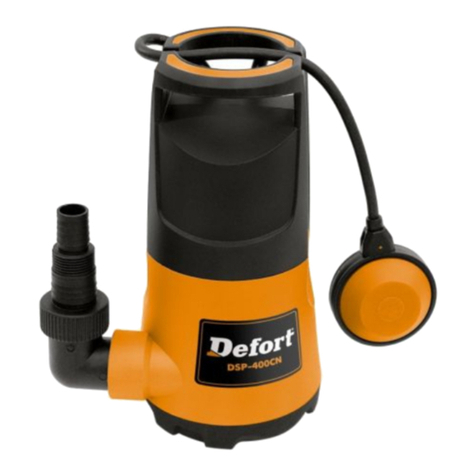
Defort
Defort DSP-400CN user manual

Graco
Graco Series A Instructions-parts list

Waterway
Waterway CHAMPS-125 owner's manual

DAB
DAB FEKABOX Instruction for installation and maintenance

pumpa
pumpa BLUE LINE 3SKM 100 Translation of the original instruction manual

Wilo
Wilo Drain MTS 40 Series Installation and operating instructions

